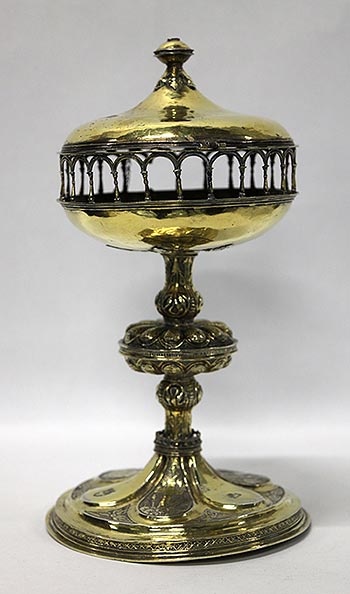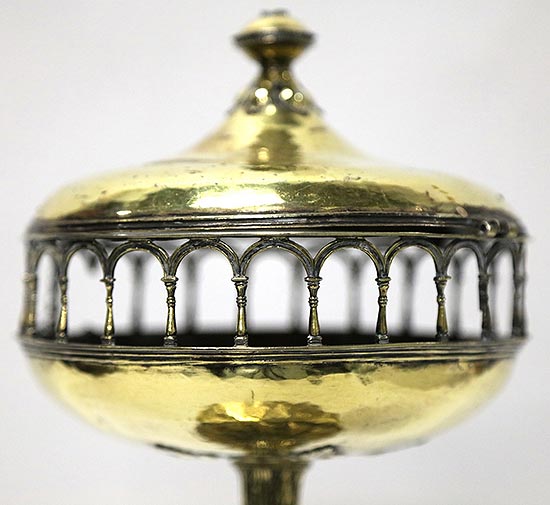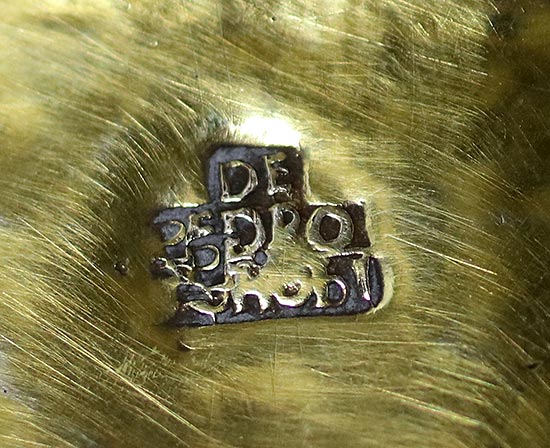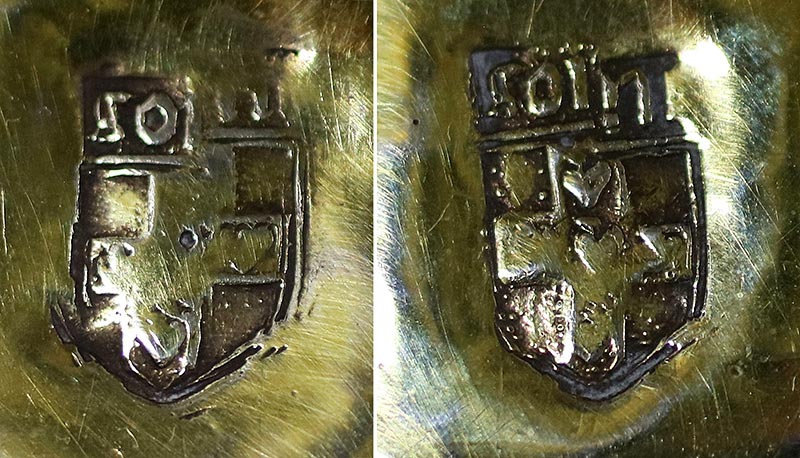The piece of the month of March 2022
NEW CONTRIBUTIONS TO THE SILVERWORK OF PAMPLONA: AN UNPUBLISHED CIBORIUM-CUSTODY BY PEDRO DE OCHOBI
Ignacio Miguéliz Valcarlos
Chairof Navarrese Heritage and Art
University of Navarra
Navarrese silverware experienced its maximum moment of splendor and wealth during the 16th century, especially in the last third, when the masters settled in the different centers of the old kingdom -Pamplona, Estella and Sangüesa- showed signs of their enormous originality. We are at a time of effervescence in terms of the work of silver. The peace and stability achieved with the annexation of Navarre to the Crown of Castile in 1512, despite the attempts of the legitimate kings to recover their throne, led to a boom in the adornment of both the nobility and the church. In this way, and through the inventories, we see little by little, and as the century progresses, an increase in the jewelry of this subject and the substitution of the old pieces in common metals for others made in silver. The paradigmatic work at this time would be the processional cross, with the parishes of Navarre competing to have the most sumptuous example. Likewise, and in line with the new uses in the liturgy, other typologies were incorporated into divine worship, such as the ciborium, which at the beginning experienced moments of uncertainty both in its typology and in its denomination, which would not be definitively established, as we know it today, until the Baroque period.
This piece began to be used after the Council of Trent's defense of the cult of the Eucharist, a Sacrament denied by the Protestants and one of the banners of the Counter-Reformation Church. It is a work destined to conserve the sacred consecrated forms, which, in turn, were kept inside the tabernacle. Typologically it derives from the pyx or hostiary with foot, subject more developed, to gradually acquire prestige by itself, developing forms similar to the chalice, work with which in many occasions it formed a pair, with base, shaft and cup with overcup. Liturgically both jewels differed in the fact that the ciborium guarded the sacred consecrated form, and the pyx or hostiarium was destined to guard those that were not consecrated. As A. Orbe Sivatte has studied in Navarre, at first the consecrated forms were kept in a small box which in turn was placed inside another piece of larger dimensions, which was the one kept in the tabernacle. Both the forms and the materials were varied, as well as the way of denominating this work, although it was never called 'ciborium'. Apparently, these pieces in the form of a box or chest with foot were called 'custodias', a broader term than what we understand today by this typology, and generally consisted of a cup with a lid inside which was kept a small box with the sacred forms, and which later gave rise to the typology of ciborium, eliminating the inner box and depositing the consecrated forms directly in the cup. An example of this would be the piece studied here and the ciborium-custody of Ochagavía, both with the box opened by a gallery of arches, which made it necessary to use a second container, or those of Tafalla and Ardaiz, with a closed box.

Among the jewelry of this type made in Navarrese workshops, we present for the first time a ciborium-custody from the beginning of the second third of the 16th century, made by the Pamplona silversmith Pedro de Ochobi (c. 1500-1560), and belonging to a private collection in Barcelona, of great interest and rarity both for its type and its origin. It is a silver-gilt ciborium-custody with a gallery of arches in the cup. This work is articulated by means of a circular base on a flat flange and triple molded base, two straight and a border of blades, with a carved upper body, in which six lobes are arranged, three decorated and three plain, alternating with three-petaled flowers engraved. It follows a molded ring, framing a border of small cells, topped by a cresting of thistle leaves that leads to the shaft, with a flattened apple knot formed by two galloned caps, separated by a border of small cells, all framed by two balustraded bodies with vegetal decoration. Semi-spherical cup with small rose of leaves and upper part crossed by a gallery of openwork arches, articulated by means of schematic columns abalaustradas on a rectangular plinth, that support arches of half point of molded thread. Truncated conical surmount topped by a flattened spherical orb, with a central molding of cells and flying edges, on which would go the Crucified, now lost.

It is a piece of slender proportions, with a careful decoration that is arranged on the architectural structure of the piece without altering it. It presents in the base and the shaft smooth moldings flown, borders of vanes and cells, cresting of thistle leaves, gadroons, flowers of three petals and vegetal elements. The decoration is completed by an iconography related to the Passion of Christ, the representation of the Arma Christi in the lobes of the base: tunic, crown of thorns and dice; cross, ladder, spear and nails; and column, rooster and whips. Meanwhile, on the plain lobes are stamped the mark of authorship and the heraldic arms of the donor, something unusual, since it is usual for these coats of arms to be engraved, chiseled or embossed, but never stamped with a punch, as if it were a mark. However, the most original element in terms of decoration in this piece is the gallery of openwork arches arranged in the cup. A gallery of this type subject is only known, as we have already mentioned, in the ciborium-custody of Ochagavía, by the same author, whose base and shaft are more advanced. Although this is a very rare architectural element as a decorative motif in Navarrese silverware and we know of no similarities in other works outside of the two pieces made by Ochobi, it should not be overlooked that arched galleries are a common element in architecture at this time, especially on the banks of the Ebro.

It is stamped on the surface of the base with a stamp of authorship, DE/PEDRO/OCHOBI, belonging to the aforementioned Pedro de Ochobi, although it lacks a locality mark. Ochobi was the son and brother of the silversmiths Juan de Ochobi the elder and Juan de Ochobi the younger. Thanks to several lawsuits in which he was involved, we have data about his family life and his relationships with other silversmiths, being one of the masters who signature the ordinances of the Pamplona silversmiths' guild of 1554. He worked for the parishes of Caparroso, Ciriza or San Lorenzo de Pamplona, as well as for private individuals, such as the Marquise of Falces. There are several works by this master that are still preserved: the chalices of Nagore and Marcaláin, the ciboria of Galar, Arraiza and Ochagavía, the cross of Beruete and the pyxides of Gollano, Osácar and Idocin. All of them are stamped with the same mark that appears in the work studied here, which only in the case of the Galar ciborium is accompanied by the stamp of the Pamplona locality. In general terms, in Ochobi's work, of great simplicity in its structure and decoration, an aesthetic of subject gothic predominates, although in some pieces we can see an evolution towards more modern postulates, as in the case of the galleries of arches of subject renaissance that we see in the ciborium-custody studied here and in that of Ochagavía. These galleries, of which no similar examples are known in Navarrese pieces, are aesthetically of great plasticity and formally very original, since they introduce an architectural element in pieces that were normally of greater sobriety, but which nevertheless, by leaving the cup open around its perimeter, oblige the use of a second box to keep the sacred forms inside the cup.

Thanks to the double coat of arms stamped on the base, GOÑI/cross charged with five panelas, we are able to identify the origin and patron of this piece, even though it came to the private collection of Barcelona where it is conserved from the art market. It is the heraldic arms, shield with gold background and gules cross charged with five golden panelas, of Don Remiro de Goñi (1481-1554), canon of the cathedral of Pamplona, who in 1525 founded the General Hospital of Nuestra Señora de la Misericordia of Pamplona, from where this piece probably comes from. The arms of the donor can still be seen today in the chapel of this hospital many times, both in the architecture and in the altarpieces of Saint Remigio and Saint Marta, part of the original decoration commissioned by Goñi, and especially in a coat of arms located on the remains of a door in the nave of the Gospel, in which it is placed next to the registration GOÑI, as well as in the ciborium-custody studied here.
Don Remiro de Goñi belonged to a family of the Navarrese nobility, son of the lord of Tirapu and Liberri, which allowed him to study at programs of study university, obtaining the degree scroll of high school program in Law by the University of Cahors in 1502, getting his doctorate in 1509 in the University of Toulouse. He oriented himself towards the ecclesiastical degree program , obtaining in 1503 two beneficiaries linked to his family in Salinas de Oro and Peralta. In the struggles between the Agramonteses and Beaumonteses he took the side of the former, being named by Queen Catherine of Albret as a member of her committee. At the same time he reached the dignity of treasurer of the Cabildo of the Cathedral of Pamplona, taking the minor orders. After the conquest he remained in the cathedral, being vicar of Amadeo de Labrit, cardinal administrator of the diocese since 1518. After the battle of Noáin in 1521 he had to go into exile in Bearne, taking advantage of the amnesty granted in 1524 by Charles V, after promising him obedience, recovering his canonry in the cathedral. Later, in 1528, he obtained the archdeaconry of La Tabla, one of the richest among the cathedral's archdeaconries, and in 1530 he changed the Bursar's Office for the archdeaconry of Usún. Finally, in 1538 he was appointed administrator of the revenues of the bishopric in vacant seat and in 1540 vicar general, visitor and apostolic judge.
Thanks to the income generated by his positions, in 1525 he was able to found the Hospital de la Misericordia de Pamplona, which after his death he declared the universal heir of his property. Goñi was in charge of the construction and endowment of the hospital, erecting not only the building, but also furnished it with grilles and altarpieces, and equipped it with everything necessary for divine worship. Of all this, the altarpieces of St. Remigio and St. Martha remain in situ, in the center of which, as we have already mentioned, are the arms of Don Remiro, the same ones that we see stamped on the ciborium-custody studied here. How and when the piece could have left the Hospital is probably to be found in the seizures of jewelry made by the Pamplona regiment, which remained as patron of the Hospital after the death of the founder, during the French and Carlist Wars, in order to cover war expenses with its sale. The identification of the origin of this ciborium-custody from a private collection in Barcelona is the second appearance of silver works belonging to the Hospital General de la Misericordia in a short period of time, after the discovery last year of some trays from the end of the 18th century in the current Hospital Complex of Navarra.
SOURCES AND BIBLIOGRAPHY
GARCÍA GAINZA, M.ª C. AND OTHERS, Catalog Monumental de Navarra. Volume V***, Merindad de Pamplona, Pamplona, Government of Navarra, 1998.
GOÑI GAZTAMBIDE, J., Historia de los obispos de Pamplona III. Siglo XVI, Pamplona, Eunsa, 1985.
HEREDIA MORENO, M.ª C. Y ORBE SIVATTE, A., Biografía de los plateros navarros del siglo XVI, Pamplona, Gobierno de Navarra, 1998.
MIGUÉLIZ VALCARLOS, I., Azafates of the hospital of Pamplona made by Pedro Antonio de Sasa in 1798.in "La pieza del mes", web of the Chair de Patrimonio y Arte Navarro, September 2021.
ORBE SIVATTE, A., Platería del reino de Navarra en los siglos del Renacimiento, Pamplona, Gobierno de Navarra, 2000.
